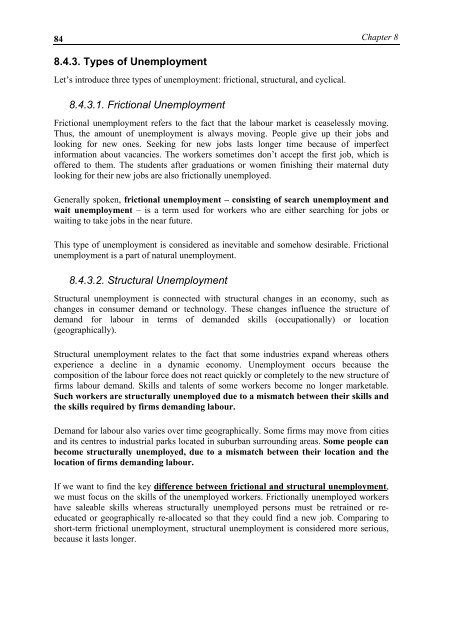MacroeconomicsI_working_version (1)
Create successful ePaper yourself
Turn your PDF publications into a flip-book with our unique Google optimized e-Paper software.
84<br />
Chapter 8<br />
8.4.3. Types of Unemployment<br />
Let’s introduce three types of unemployment: frictional, structural, and cyclical.<br />
8.4.3.1. Frictional Unemployment<br />
Frictional unemployment refers to the fact that the labour market is ceaselessly moving.<br />
Thus, the amount of unemployment is always moving. People give up their jobs and<br />
looking for new ones. Seeking for new jobs lasts longer time because of imperfect<br />
information about vacancies. The workers sometimes don’t accept the first job, which is<br />
offered to them. The students after graduations or women finishing their maternal duty<br />
looking for their new jobs are also frictionally unemployed.<br />
Generally spoken, frictional unemployment – consisting of search unemployment and<br />
wait unemployment – is a term used for workers who are either searching for jobs or<br />
waiting to take jobs in the near future.<br />
This type of unemployment is considered as inevitable and somehow desirable. Frictional<br />
unemployment is a part of natural unemployment.<br />
8.4.3.2. Structural Unemployment<br />
Structural unemployment is connected with structural changes in an economy, such as<br />
changes in consumer demand or technology. These changes influence the structure of<br />
demand for labour in terms of demanded skills (occupationally) or location<br />
(geographically).<br />
Structural unemployment relates to the fact that some industries expand whereas others<br />
experience a decline in a dynamic economy. Unemployment occurs because the<br />
composition of the labour force does not react quickly or completely to the new structure of<br />
firms labour demand. Skills and talents of some workers become no longer marketable.<br />
Such workers are structurally unemployed due to a mismatch between their skills and<br />
the skills required by firms demanding labour.<br />
Demand for labour also varies over time geographically. Some firms may move from cities<br />
and its centres to industrial parks located in suburban surrounding areas. Some people can<br />
become structurally unemployed, due to a mismatch between their location and the<br />
location of firms demanding labour.<br />
If we want to find the key difference between frictional and structural unemployment,<br />
we must focus on the skills of the unemployed workers. Frictionally unemployed workers<br />
have saleable skills whereas structurally unemployed persons must be retrained or reeducated<br />
or geographically re-allocated so that they could find a new job. Comparing to<br />
short-term frictional unemployment, structural unemployment is considered more serious,<br />
because it lasts longer.




